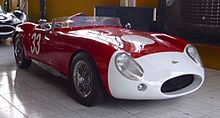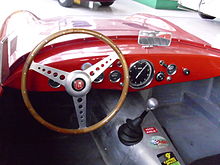Patriarca
Patriarca was an Italian racing car manufacturer based in Rome and later in Nemi . After the Second World War, the family business produced some racing cars for smaller motorsport classes that were used exclusively in Italy.
Company history
The company was founded in 1933 by Rodolfo Patriarca. It was based in the city center of Rome and in the first few years was purely a repair shop for automobiles. Rodolfo Patriarca noticed early on that his primarily urban customers were interested in performance-enhanced automobiles. That is why he soon offered engine machining and, if requested, also carried out other interventions in the customers' cars, such as weight reductions. Patriarca's customers at this time included politicians as well as well-known racing drivers; among them were Piero Taruffi , Luigi Musso , Salvatore Casella and - later - Maria Teresa de Filippis .
From 1948 on, Patriarca designed and built several racing cars that were used by different drivers and produced in small numbers. The last vehicle of its own was built in 1974. Patriarca then concentrated initially on the preparation of Formula Ford or Super Ford racing cars . One of the vehicles prepared by Patriarca in this context was used by Enzo Coloni in the late 1970s with some success, the Founder of the Umbrian racing team and Formula 1 team named after him . The Patriarca company is now based in Teramo and is once again focusing on the repair of automobiles.
Cars from Patriarca
Patriarchal 750
In 1948 Patriarca designed its first racing car, which was intended for the 750 Sport class. The Patriarca 750 was a small car with a 750 cubic centimeter four-cylinder in-line engine from Fiat , which was developed in collaboration with the later Roman Fiat tuner Giannini. The engine's output was given as 42 hp. Individual replicas of this car were made up to 1954.
The Italian racing driver Sesto Leonardi took part in numerous national tours with the car in 1949 and 1950. Patriarca's design competed here with vehicles from Giaur and Stanguellini . In 1949 Leonardi won the championship title in class 750 on the Patriarca.
In 1949 and 1950 Leonardi took part in the Mille Miglia with the Patriarca . In the first year he left early; In 1950, however, he came in 24th and crossed the finish line first in his class. The subsequent tours on the Circuito del Castello in June 1950 and on the Circuito de Collemaggio in July 1950 Leonardi won with the Patriarca 750. After a two-year hiatus, the Patriarca reappeared in circuit races in 1953 and 1954. Various drivers moved the car, but could not achieve any outstanding success.
A Patriarca 750 Sport from 1950 took part in the Mille Miglia in 2012.
Patriarchal 1100
The 1100 model was created in 1951 . A four-cylinder engine with a displacement of 1089 cm³ provided the drive. The body came from Pininfarina . An Italian vehicle dealer put a Patriarca 1100 up for sale in May 2012.
Baby junior
In 1959, Rodolfo Patriarca's sons Bruno and Franco designed another racing car that was intended for the Formula Junior established in 1957 . By 1964, 18 copies of the vehicle called Baby Junior had been built . The car had a tubular frame and in most cases had 500 cubic centimeter engines from Fiat or Steyr-Puch . Three copies were equipped with an engine enlarged to 850 cubic centimeters. The cars were driven by different pilots; His designer, Bruno Patriarca, was one of them. With the introduction of the new Formula 3 in 1964, the production of racing cars at Patriarca ended.
More vehicles
In 1968 Bruno Patriarca designed a small Gran Turismo based on a production vehicle from Lancia . The vehicle remained a one-off as well as an all-terrain vehicle constructed in 1974 that used the drive technology and mechanical components of the Fiat 500 . After that, Patriarca stopped building its own automobiles.
literature
- Peppino Valerii: Storia di uomini e motori . Company history of Patriarca in: Auto d 'Epoca issue 3/2009, p. 58 ff.
- Georg Amtmann and Halwart Schrader : Italian sports cars . Stuttgart 1999, ISBN 3-613-01988-4 .
Web links
- Overview of the races of the Patriarca 750 on the website www.racingsportscars.com (accessed on June 7, 2011).
- Image of a Patriarca 750 (accessed June 7, 2011).
Individual evidence
- ↑ Start number 142 at the Mille Miglia 2012 ( page no longer available , search in web archives ) (English, accessed on June 30, 2012)
- ↑ Description of the model on the dealer's website ( Memento from April 15, 2012 in the Internet Archive ) (English, accessed on June 30, 2012)
- ↑ Overview of the results of the Formula Junior on the website www.formula2.net ( Memento from October 11, 2007 in the Internet Archive ).



